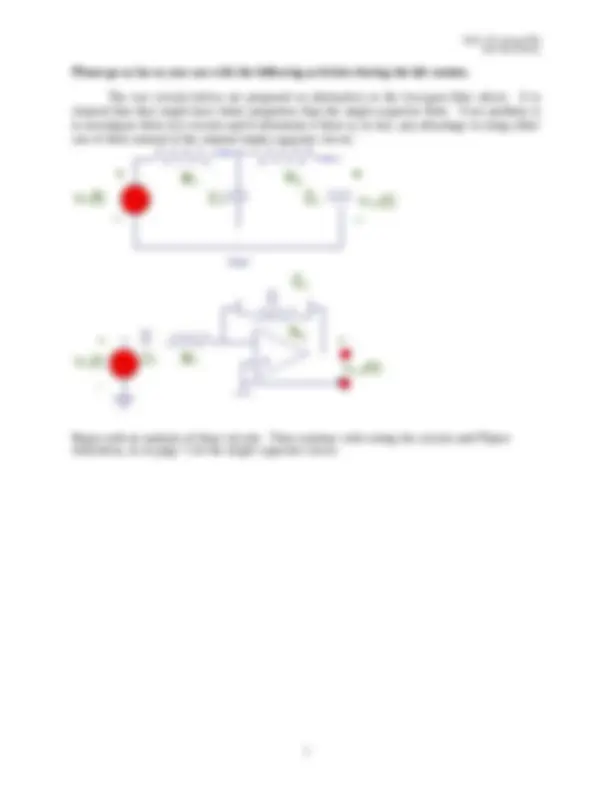
ELEC 226, Spring 2003
Prof. Rich Kozick
Laboratory 1: Frequency Response Measurements
January 16 and 23, 2003
Introduction: The objective of this lab is to review measuring the frequency response (magnitude and
phase) of a low pass filter. We will try to relate your measured results to analysis using phasors and
impedance as well as simulation with PSpice.
Background: We will consider the following low pass filter circuit.
Instructions:
1. Analytically determine the frequency response of the circuit for both the magnitude gain and the
phase difference between the input and output signals at sinusoidal steady state.
2. “Build” the circuit in Figure 1 in Pspice. In the Setup menu, select “AC Sweep”. For the ac sweep,
select a start frequency of 100 Hz, an end frequency of 100 kHz and an AC sweep type of “decade”.
Save your schematic and then select “Simulate” from the Analysis menu. In Probe, plot vout/vin. This
will plot the magnitude of vout/vin.
3. Copy the magnitude data to Excel by highlighting (clicking) the name of the variable at the bottom of
the plot and then copying the data using the “copy” button or “Copy” from the Edit menu. When the
data are selected the name of the variable will be highlighted in red. Open Excel. Select “Paste
Special” from the Edit menu. Select “Paste” and “as text” and then “ok”. Later in the lab, you will
plot the data along with the experimental data to be measured during this lab.
4. In Probe, delete all traces. Plot the phase angle between vin and vout. Select “Add” from the Trace
menu. On the right hand of your menu will be options for different functions: ATAN (calculates the
inverse tangent in radians), IMG (takes the imaginary part of the variable selected), and R (takes the
real part of the variable selected). To plot the phase difference between vin and vout, select
ATAN(IMG(vout)/R(vout))*360/2/pi where vout is the voltage across the capacitor in your circuit. (This
assumes that you left the phase angle of vin as zero degrees when you “built” the circuit.) Copy this
phase angle data to Excel.
5. Experimentally measure the the magnitude of vout/vin and the phase difference between vin and vout
from 100 Hz to 100kHz. Set the function generator to sine and select an amplitude of 1 Vpp. Record
your experimental data in Excel.
6. In Excel, plot the Pspice data of magnitude of vout/vin as a function of frequency using a logarithmic
axis for the x axis and a scatter plot. Add the experimental data of magnitude of v out/vin as a function
of frequency to the plot as another series. Also add data based on evaluating your analytical
expression from item 1 (you can compute this data for a few frequencies using your calculator, or
you can use formulas in Excel).
7. In Excel, plot the Pspice data of the phase angle between vin and vout as a function of frequency using
a logarithmic axis for the x axis and a scatter plot. Add the experimental data of the phase angle
between vin and vout as a function of frequency as another series, and the analytical data.
8. How do the experimental, Pspice, and analytical data compare?
9. Can you identify the cutoff frequency in your plot, and compare it to the analytical cutoff?
1
+
V o u t
-
+
V i n
-
kR 1
FC
1.0
F i g u r e 1










